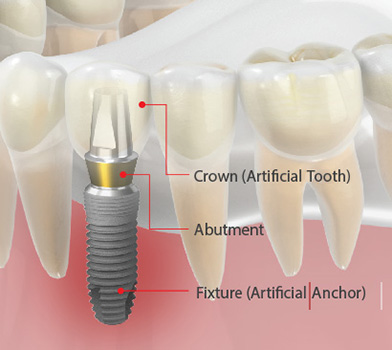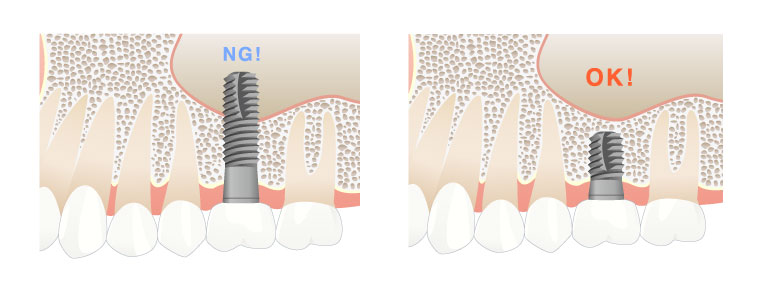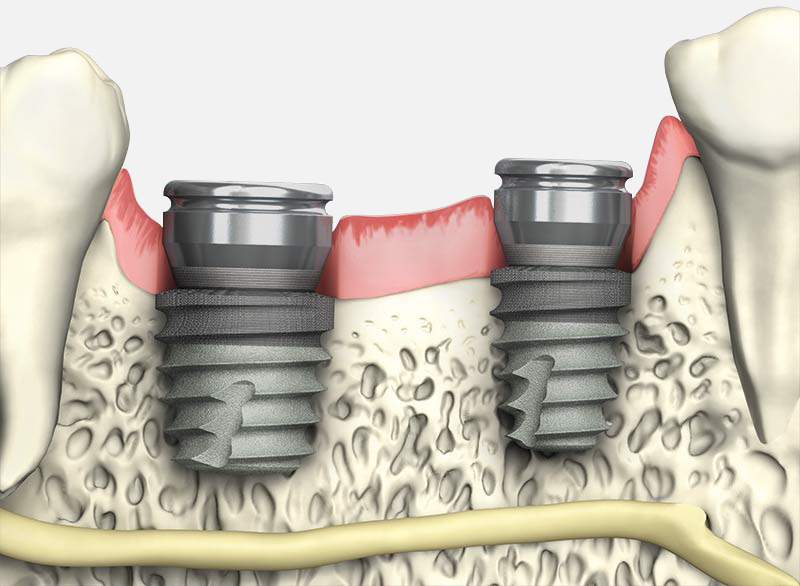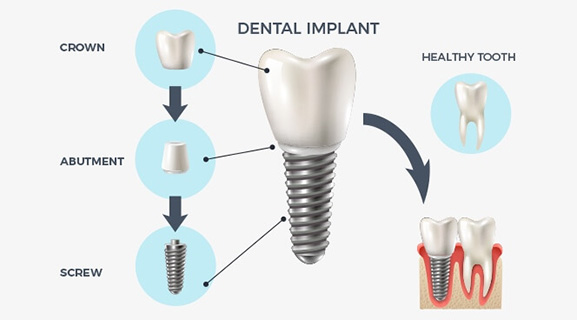Short dental implants are used at St. Lawrence Dentistry when there is minimal bone available for their placement. Minimally invasive implant dentistry looks at the existing bone volume available for implant placement and the eventual support needed for dental crowns. Instead of focusing on trying to add more bone by grafting, Dr. Hawryluk Jr. looks at ways to use existing bone volumes. Some of the tools for this are ‘guided surgery,’ use of tilted implants to avoid anatomic structures, and shorter implants.

To learn more about guided implant surgery please visit us here:
BioHorizons Guided Implant Surgery
Because of technological advancements, there is a trend toward less bone grafting and the use of shorter implants. In the past, Dr. Hawryluk routinely grafted sites first in areas of limited bone for implant placement. Now new innovative short implants offered by BioHorizons lessen the need for grafting.
Research is very active in the use of short implants (less than 8.5 mm). A study by Atieh in the journal of oral and maxillofacial surgery found that out of 3573 short implants placed; there was 67 that failed. In other words, the cumulative 5-year survival rate was 98.3%. Other studies focusing on longer implants in these applications showed a success rate of 97.3%. Dr. Hawryluk has found similar success rates in his clinical practice using short implants. All in all, if placed correctly, there is no significant difference between the standard and short length implant success rates. One exciting finding is short implants have a slightly higher success rate in the lower jaw compared to the maxilla (upper jaw).

The crown to implant ratio matters when considering the success of short implants. Dr. Hawryluk carefully considers this when planning implant cases for patients. In traditional dentistry, a longer root often means it is stronger and more able to support a dental bridge. If you apply a lateral load to a tooth, it will rotate just below the midpoint of the root. When you start to get into a 1:1 crown to root ratio, things will become unfavorable. An implant is not like a tooth in that it is integrated with the bone and does not rotate. Therefore the comparison of a tooth crown to root ratio is different from a crown to implant ratio.
When we look at stress analysis of implants, we constantly see they are stressed the highest at the crest of the bone ridge (area closest to the gum line) and around the neck of the implant, with some stress also being at the apex (bottom of the implant in the bone). The conclusion drawn from this is short and long implant acts very similarly concerning how they tolerate forces.

The crown height (and the abutment connector between implant and crown) however does matter. To look into this we need to review a little physics:
Moment = force x distance
If you have a 100 Newtown force applied to a part of an implant crown, which is 2 centimeters away from its supporting abutment than you will have a 200 Ncm torque applied to the implant. A taller dental crown means a greater distance from the chewing force to the implant base. This greater distance means greater moment force if the energy is not entirely vertically directed. If controlling the moment forces properly, a high crown to root ratio does not lead to increased implant failure or bone loss around an implant.
With this in mind, it is clear that as long as the chewing forces are in the confines of the implant diameter the stress and stains felt by the implant will be the same no matter what the crown length. However, if the implant crown is wider we will have moment force occurring because the force is outside the confines of the implant support. Therefore a crown with a narrow implant base can have greater stress and strain around the neck of the implant. To ensure the success of your dental implants, Dr. Hawryluk will design your dental implant crowns with this basic physics in mind.

Sometimes wider dental implants are placed when only a short length is possible. However, some studies have shown wider implants do not always correspond to increases stability. Dr. Hawryluk feels wide dental implants can be very beneficial, but the ideal bone volume around them must be present to support them. In summary, as long as we stay within the physiologic limits of the bone, your dental implant will be able to handle the load.
Tall crowns can have more mechanical complications than biologic ones. For example, screws (holding a dental crown to the implant) can loosen or break more often in tall dental crowns, especially if crown heights are more than 15 mm long. To circumvent this issue, Dr. Hawryluk will often use a ‘screw-retained’ implant crown, which is easily serviceable.
The primary way to reduce forces on short implants with long crowns is to splint them together. Biomechanics studies show that splinting implants creates an environment of less stress. Splinting of short implants improves stress distribution, decreases screw loosening, and improves cement retention. The disadvantage is, in some cases, splinting dental crowns together makes hygiene cleaning more difficult.

Another way to improve the prosthetic outcome when using short implants is to use an ‘implant abutment.’ These are connectors that join an implant and a crown. If the dental crown and implant are one piece, it increases the possibility of a misfit at the implant level. This misfit can cause ‘micro-gaps,’ bone inflammation, and loss. Dr. Hawryluk always uses the best possible prosthetic connectors. Also, narrowing the width of crowns, avoiding cantilevers (extra dental prosthetic hanging off an implant), and ensuring vertical loading ( reducing moment force discussed above) will all help with implant success.
All in all, in areas of limited bone around molar and premolar teeth, we do not always have to ‘bone graft’ to put in longer conventional implant lengths. If you are looking for a dentist in the Mississauga area or would like to discuss this topic further please give us a call.
Reference: Short Implants: Dental XP, 2017.
- St. Lawrence Dentistry Looks Forward To St. Patrick’s Day! - March 12, 2025
- Understanding Dental X-Rays and Radiation: What You Should Know - January 13, 2025
- Happy New Year from St. Lawrence Dentistry! - December 30, 2024










